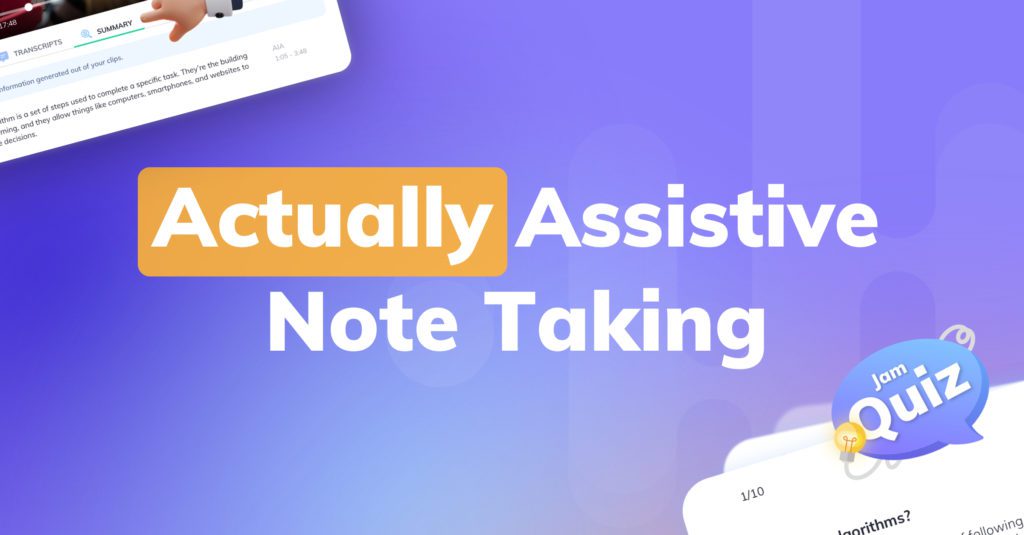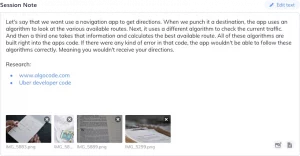Understanding how to take notes is an essential skill for all university students. However, it’s likely you were never taught how to take notes effectively during lectures and seminars. For most students, note-taking is used to capture lecture content word for word. Or, students rely on lengthy lecture recordings to watch the content back and then take notes. However, both of these approaches are robotic, time-consuming, and ineffective. Even if you have a structured note-taking technique, it can be difficult to get things down quickly enough as the lecture or seminar occurs. In this blog, we’ll share how to take notes effectively and efficiently using Jamworks as an assistive note-taking tool for capturing everything, while taking notes that keep you engaged and organised.
How to Take Distraction-Free Notes

The hardest thing to do in lectures is stay focused. Yet, this is the most important aspect of learning how to take notes in lectures and seminars. Good listening skills are essential for making sense of the learning material and then turning this into notes. To get the most out of lectures, it’s best to be present, listen attentively, and actively try to understand what you’re being taught. However, staying focused and trying to remain attentive is easier said than done. How do you balance capturing all the information being presented while trying to understand the subject?
Jamworks is the ideal note-taking tool to solve this problem. Using this personal productivity learning tool, you can record lectures and seminars with assistive note-taking features. Unlike regular recordings, Jamworks allows you to break down the lecture material using 1-button highlighting. Every time you select the Highlight button Jamworks will convert what was said into text and use AI to summarise the lecture content into a bite-sized study note. This simple yet powerful features make it possible for you to focus on listening and understanding, rather than worrying about getting everything down. After the lecture, your notes are already well-organised using Jamworks which removes the need to rewrite everything or skip through lengthy lecture recordings to catch up.
How to Capture Lecture Content using Jamworks’ Highlights
1-button highlighting is a key Jamworks feature that makes distraction-free note-taking seamless. This feature allows you to pick out key topics, themes, and sections of the lecture material. But, what exactly should you aim to highlight? How can you break down the content into meaningful highlights? Many students face this problem when learning how to take notes. Ideally, a good highlight choice is something that is focused and well-defined. This will make it easier for you to separate studying into topics and subtopics later.
First, the easiest way to start off with 1-button highlighting is by looking out for the key topics. These are the broad areas that the lecture focuses on and might have been given as the lecture outline, or presented as headings on the slides. If you have preliminary reading, this can provide a guide for the topics you will see during the lecture. You can highlight each topic that relates to the reading. For some lectures, it can be harder to pick out smaller topics. Especially with complex material, an entire lecture might be dedicated to breaking down that concept.
Effective Highlight Ideas
Instead, you can look out for some of the following to create highlights:
- Discussion points: This might be popular debates surrounding a topic or something the lecturer has encouraged you to think about with your peers.
- Examples: If your lecturer uses examples to elaborate on a concept or theory, this is good to keep track of. This might be given as a class activity or could be a piece of supporting research that was shared.
- Themes: Instead of a single defined topic, your lecture material might have themes. This can be a good way to approach creative or humanity-focused subjects.
- Arguments: For well-known theories and concepts, you might find there are many key arguments or schools of thought surrounding the idea. You can break lecture material down into the main arguments which will be useful for developing a critical understanding.
- Processes: This could be steps in a process such as the timeline of child brain development, or a sequence of steps. Instead of highlighting this process as one topic, break your highlights down into each step or group the steps into parts, such as phase 1, or ‘early stages’.
- Summaries: If your lecturer provides an overview or summary of the key topics covered in a section, make a highlight. This is the ideal material to revisit for a quick recap or to check you’ve understood everything.
In addition to 1-button highlighting, Jamworks’ offers the Trackback feature for when you lose focus. During lectures, it can be easy to miss a point or not realise something was important until the lecturer is a few minutes into explaining. You can use Trackback to skip back through the lecture recording and start a highlight from a few seconds or minutes earlier.
How to Take Notes Effectively

Each highlight has a notes section where you can add your own thoughts, questions, and ideas. Using Jamworks, you can be sure everything is being captured for you and instead focus on making meaningful notes.
However, when you’re used to attending lectures simply to capture information, it can be hard to know how to take notes that are useful. Don’t worry, it’s actually more simple and more intuitive than you might think.
Notably, understanding is an important part of learning that improves the effectiveness of revision and learning overall. To understand something, you need to be able to listen and let your mind wander. Being able to listen attentively will bring up thoughts about the topic, or help you connect the information to previous knowledge. If you’re focused on getting things down, it’s likely you can’t attend to these thoughts. These personal thoughts and connections are the perfect things to write down.
By actively thinking about the material, and relating it to your knowledge, thoughts, and experiences, you’re more likely to remember and develop critical thinking skills. Beyond your own thoughts, try to think about the significance of the material and how it might fit into the bigger picture. In the notes section, you can also jot down key dates, names, and terms, or use abbreviations for complex terminology. Write down anything that you feel will supplement your understanding and, make note of things you don’t understand. What questions did the material leave you with? You can also attach files later to each highlight to keep your learning material organised.
Clutter-Free Notes with Jamworks’ Flags
Understanding how to take notes allows you to get your thoughts down, and consider connections between material. While notes are incredibly useful, sometimes you just need to mark something as important for later. Jamworks’ flag feature is perfect for pointing out the information you need to come back to. This is a useful tool to avoid cluttering up the notes section with reminders.
Flags could be used to mark every time your lecturer mentions the exam, or to document each piece of information you think could be used in your upcoming assignments. This saves you from having to pick this information out later on and gets you thinking about assessments early. Flags can be used for anything that is useful to you so consider how you can declutter your notes by making use of flags.
Revise with Jamworks’ AI-powered Study Notes

After lectures, it’s routine for most students to rewrite their lecture notes at some point. You might focus on highlighting, summarising, and condensing these notes for revision or assignments. This process usually involves filling in the gaps from zoning out in lectures and organising lecture material. This is important! You need concise notes that are well-defined and easy to review to revise effectively and develop a good understanding of the material. Despite its importance, it’s easy to slip into procrastination because of how time-consuming rewriting notes and re-listening to multiple lectures can be. That’s why Jamworks’ uses the power of AI to summarise highlights into bite-sized study notes.
Overall, Jamworks’ highlights reduce the need to listen to an entire lecture back. You can review each highlight as an AI-powered summary, a word-for-word transcript note, or an audio clip from the original lecture material. The full transcripts and AI-powered study notes capture everything you need so you don’t need to write up more notes. Instead, you can focus on your assignments and exam revision. Jamworks also provides flashcard-style quizzes, which are generated automatically out of the most important parts of you lecture (your highlights!). You can use this feature to test your understanding and knowledge early on.
The Companion Tool for Written Notes

If you’re more of a pen-and-paper kind of person, Jamworks will allow you to take handwritten notes, distraction-free. You can use highlights to break the recorded lecture content into easy-to-access chunks. Flags and AI-powered summaries can be used to make sure you have all the relevant content on hand. For highlight notes, you can scan handwritten notes and attach them as a PDF file for later. This will enable you to take the most out of popular paper-based note-taking strategies, such as the mapping method. This is especially useful if you’re a visual learner who prefers information to be displayed in a less structured way or for some subjects that have a lot of diagram-based learning and practice questions to work with. Jamworks will allow you to focus on writing instead of capturing content.
Start taking better notes today with Jamworks – click here to get started.